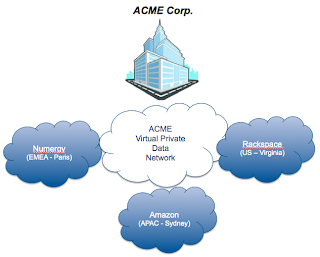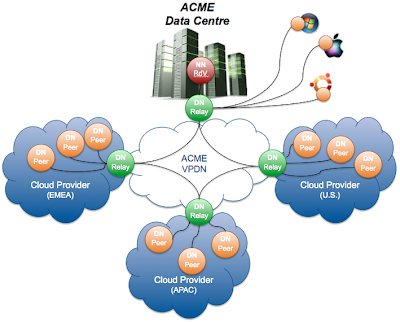Data Replication in a Multi-Cloud Environment using Hadoop & Peer-to-Peer technologies
要FQ。。。
——————————————————————————————————————————————————————
Few years ago, i started working on a project named Jxtadoop providing Hadoop Distributed Filesystem capabilities on top of of a peer-to-peer network. This initial goal was simply to load a file once to a Data Cloud which will take care of replication wherever the peers (data nodes) are deployed... I also wanted to avoid putting my data outside of my private network to ensure complete data privacy.
After some times, it appeared that this solution is also a very good fit to support data replication in a Multi-Cloud Environment. Any file (small or big) can be loaded in one cloud and then gets automatically replicated to the other clouds. This makes multi-cloud Data Brokering very easy and straightforward.
Hadoop is a very good candidate to provide those functionalities at a datacenter level. However when moving to a multi-cloud environment, it is no longer viable unless a Virtual Private Data Network is built. This VPDN is created on top of a peer-to-peer network which provides redundancy, multi-path routing, privacy, encryption across all the clouds...
Concept
Let's assume we are in a true Multi-Cloud Broker environment. For this blog, i assume i actually have 3 clouds hosting multiple workloads (aka virtual servers) in each. The picture below depicts a classical configuration which will appear in the coming years where business will source IT from different Cloud providers and really consume IT in a true Service Broker model.

ACME Corp. has its headquarters based out of France and subsidiaries all over the world.
The new strategy is to source IT infrastructure from local service providers to deliver IT services directly to the local branches. There is no will to set up local IT anymore.
Data replication, propagation, protection (...) is really an issue in such a configuration and reversibility has to also be configured.
Setting up this Virtual Private Data Network will support this Service Broker Strategy.
Conceptually, the solution is very simple. A master node (calledRendez-vous Namenode) is located in the HQ and is the brain of the VPDN. That's where all the logic is handled such as data availability, multi-path data transfer, data placement... In each Cloud, there is a Relay Datanode which acts as the entry point for the Cloud. It will play a routing role communicating directly with other Cloud relays and also play a buffering role for data transmission. To avoid any SPOF, all those peers can be deployed in a multi-instance mode.
Finally each workload instance (physical servers, virtual machines, containers...) hosts a Peer Datanode which is the actual endpoint for data storage and consumption.
Virtual Private Data Network Architecture
As explained in the previous section, the overall architecture relies on three main components.

- Namenode Rendez-Vous providing Data Transport Logic as well as Data placement and replication. It has the peer-to-peer network topology overall understanding as well as the data cloud meta-data. There is no data traffic going through this peer.
- Datanode Relay providing Data Storage as well as Data Transport. The local peers which can communicate between each others through multicast, will rely on the relays to communicate with remote peers located in other data clouds. It can also store data as a temporary buffer.
- Datanode Peer providing Data Storage to store data chunks on each server peer and even on remote desktop peers.
All the peers can be made redundant (multiple Rendez-Vous, multiple Relays ...) to increase the multi-path routing capability and avoid any SPOF. The data is then split into chunks of pre-defined size and dispatched across the Data Cloud. Data locality can be set to ensure there is one replica per Cloud or that replicas are limited to a Cloud (for example for data which must stay in a specific country).
All the communications are multi-path, authenticated, encrypted... There is no need to set-up VPNs between the Clouds which could lead to some contentions points. Here the communication is either direct through multicast or going through the best (shortest) routing path at the peer-to-peer layer level.
The traffic flows are of 2 kinds.
. The RPC flow and the DATA flow. The first one handles all the signaling required to operate the VPDN such as routing, heartbeat, placement requests, updates ... There is actually no business data on this flow, hence it is possible to have a set-up where data traffic is limited to a cloud or even a country while the commands are centrally managed.
. The DATA flow is the actual business data transferred over the wire. This flow can be local to a datacentre using multicast wherever possible. It can also still be local but transiting through the Cloud relay for multiple domains. Finally this flow can go through multiple relays. In the example below, a data block located on the Windows PC will get replicated to the APAC Cloud by going through 2 relays (the DC one + the APAC Cloud one).
Benefits
This new approach brings many benefits for a mutli-Cloud environment and for companies willing to operate their IT with an IT Service Broker model.
- Redundancy : the data is automatically replicated in the Clouds wherever needed ;
- Availability : the data is always available with the use of multiple replicas (3, 5, 7...) ;
- Efficiency : quick deployment, quick capacity expansion ;
- Simplicity : load once on a peer and automated replication ;
- Future-proof : leverage big data technologies ;
- Portable : can run on any server and desktop platforms supporting Java 7 ;
- Confidentiality : all the data transfer are encrypted, authenticated ... ;
- Locality : data can be located in a specific Cloud and not leak outside ;
Setting up your own environment
The technology used to create this Virtual Private Data Network can be found here. The testing described above has been done using a physical environment from OVH in France to simulate the HQ. 3 clouds have been consumed :Numergy (EMEA - France), Rackspace (U.S. - Virginia) and Amazon (APAC - Australia).
The testing leveraged Docker to create multiple Datanode peers on a single VM with a complex network topology (see1 & 2). The associated containers can be found on the Docker main repository :
- Namenode Rendez-Vous (jxtadoop/namenode)
- Datanode Relay (jxtadoop/relay)
- Datanode Peer (jxtadoop/datanode)
Desktop clients have been installed on Mac OS, Windows and Linux. Just ensure you use Windows 7.
Conclusion
This concludes my Jxtadoop project which will get released as version 1.0.0 later this month. I'll provide a SaaS set-up with a Rendez-vous Namenode and a Relay Peer for quick testing.
Next ideas :
- Roll-out StandaloneHDFSUI for Jxtadoop ;
- Release FileSharing capability based on Jxtadoop ;
- PaaS/SaaS set-up for Jxtadoop with Docker and CloudFoundry ;
- Think about magic combination of App Virtualization (Docker), Network Virtualization (Open vSwitch) and Data Virtualization (Jxtadoop) ;
Links
Data Replication in a Multi-Cloud Environment using Hadoop & Peer-to-Peer technologies的更多相关文章
- elasticsearch6.7 05. Document APIs(1)data replication model
data replication model 本节首先简要介绍Elasticsearch的data replication model,然后详细描述以下CRUD api: 1.读写文档(Reading ...
- ACID、Data Replication、CAP与BASE
ACID 在传数据库系统中,事务具有ACID 4个属性. (1) 原子性(Atomicity):事务是一个原子操作单元,其对数据的修改,要么全都执行,要么全都不执行. (2) 一致性(Consiste ...
- 【Cloud Computing】Hadoop环境安装、基本命令及MapReduce字数统计程序
[Cloud Computing]Hadoop环境安装.基本命令及MapReduce字数统计程序 1.虚拟机准备 1.1 模板机器配置 1.1.1 主机配置 IP地址:在学校校园网Wifi下连接下 V ...
- 6 Multi-Cloud Architecture Designs for an Effective Cloud
https://www.simform.com/multi-cloud-architecture/ Enterprises increasingly want to take advantage of ...
- Hive-0.x.x - Enviornment Setup
All Hadoop sub-projects such as Hive, Pig, and HBase support Linux operating system. Therefore, you ...
- Enabling granular discretionary access control for data stored in a cloud computing environment
Enabling discretionary data access control in a cloud computing environment can begin with the obtai ...
- Tagging Physical Resources in a Cloud Computing Environment
A cloud system may create physical resource tags to store relationships between cloud computing offe ...
- Awesome Big Data List
https://github.com/onurakpolat/awesome-bigdata A curated list of awesome big data frameworks, resour ...
- Scalable MySQL Cluster with Master-Slave Replication, ProxySQL Load Balancing and Orchestrator
MySQL is one of the most popular open-source relational databases, used by lots of projects around t ...
随机推荐
- SQL Server Latch Classes Library
https://www.sqlskills.com/help/latches/ (Companion SQL Server Wait Types Library) This site lists al ...
- mormot 数据集和JSON互相转换
mormot 数据集和JSON互相转换 uses SynVirtualDataSet, mORMotMidasVCL, SynCommons; procedure TForm1.Button1Clic ...
- Build a Restful Service
最近项目中遇到的REST的问题很多,很多情况下受weblogic以及Jdeveloper版本的影响,无法直接从Jdeveloper中生成一个RESTful Service出来,所以基于流行的Sprin ...
- git如何打补丁?
git cherry-pick 可以把某个分支的某几次提交合入到当前分支,只是在一台设备上操作. git format-patch 可以把某个分支的n次提交分别打成n个补丁,然后把这些补丁文件(比如0 ...
- UNDO表空间损坏导致数据库无法OPEN
在数据库undo表空间文件损坏.或者undo表空间文件缺失的情况下.无法打开数据库. 这两种情况都能够视为一种情况处理,解决方法一样. 场景:在23:10的时候新建一个undo表空间undotbs02 ...
- HTTP—缓存
1. ETag HTTP 1.1中引入了ETag来解决缓存的问题.ETag全称是Entity Tag,由服务端生成,服务端可以决定它的生成规则.如果根据文件内容生成散列值.那么条件请求将不会受到时间戳 ...
- http://zhidao.baidu.com/link?url=fX6C1xFLsqiuTY88cjwJYal2x52rOwlJstmz7KWyMc6l9j3FHw2yhvp83timZ86pwhqQ8rONj2xkgo2wbU2tLK
http://zhidao.baidu.com/link?url=fX6C1xFLsqiuTY88cjwJYal2x52rOwlJstmz7KWyMc6l9j3FHw2yhvp83timZ86pwhq ...
- C# 操作mongodb 简单实例
本实例主要简单的查询,新增,修改和删除操作,完整代码如下: using System; using System.Collections.Generic; using System.Text; usi ...
- 转: android 内存检测工具 LeakCanary 说明
http://www.liaohuqiu.net/cn/posts/leak-canary-read-me/ LeakCanary 中文使用说明 10 May 2015 LeakCanary Andr ...
- 动态创建的文本框想要加上jQuery的datepicker功能变成日期选择控件该怎么办?
通常页面输入控件想得到日期选择功能,借助jQuery是这样实现的: 1.载入css和js <script src="jqueryui/jquery-ui.js" type=& ...
